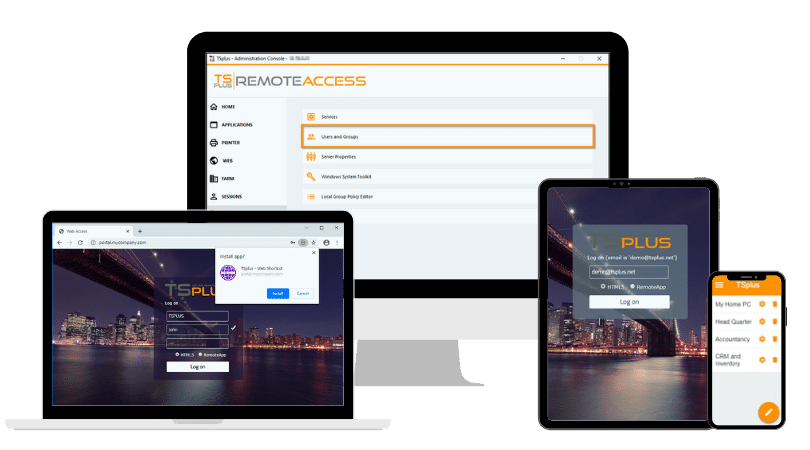"Citrix File Share Alternative"
Looking for a Citrix file share alternative? Discover 7 secure & cost-effective solutions for file sharing, remote access and collaboration in 2025. Compare top options like TSplus, Egnyte, Box and more.
Would you like to see the site in a different language?
TSPLUS BLOG
Transferring files from a remote desktop (RDP) to a local PC can be done using copy-paste, drag-and-drop, shared drives or secure FTP tools. The choice of method will depend on file size, network conditions and user needs. TSplus Remote Access offers a faster and more reliable solution with its built-in File Transfer tool and the added ability to open files remotely without downloading them, thus making it ideal for mobile and professional users alike. The article also highlights key security practices and troubleshooting tips to ensure safe and efficient file transfers.
)
If you frequently work remotely using Remote Desktop Protocol (RDP), moving files quickly from your remote session to your local PC can be critical, especially when dealing with large data sets or tight deadlines. In this guide, discover the fastest and most efficient and secure ways to transfer files from an RDP session to your PC. Whether you are a system admin, remote worker or IT consultant, this article provides a range of practical solutions, including native Windows tools and advanced options like TSplus Remote Access.
File transfer speed over Remote Desktop Protocol (RDP) depends on more than just your internet connection. Several factors work together to affect how fast files move between the remote desktop and your local PC, amongst them:
Network conditions like latency (delay) and available bandwidth play a big role. A slower connection or heavy network traffic can make even small moves take much longer than expected. Working over Wi-Fi, signal strength and interference from other devices will also affect speed.
Both the size and number of files you transfer matter. Indeed, large files or folders with many items take longer to process, especially when using clipboard or drag-and-drop methods. These basic tools are often poorly designed to handle big data transfers efficiently.
Finally, the method you choose has a direct impact. Native tools like clipboard or mapped drives are easy to use but may lack speed and reliability. Advanced tools like TSplus or SFTP clients provide more consistent performance, especially for large or frequent exchanges.
Choosing the right method can significantly reduce file transfer time and frustration. The key is to match the tool to your needs by considering file size, security, ease of use, etc.
Now that we know what affects the speed of a file transfer, let us dive into how to move them rapidly:
If you are using Windows 10 or 11 Pro or Enterprise edition and connecting via the built-in Remote Desktop app, you can drag and drop files directly between the remote desktop and your PC.
This method is fast and intuitive for single files or small folders. However, it might not work on older RDP clients or mobile RDP applications.
A universally available method:
This feature is simple and needs no configuration. Yet, it is limited to small files around 1 to 5 MB and is often disabled by admins.
Tip: In case of issues, check that "Clipboard Redirection" is enabled in both the RDP client settings and Group Policy. Group Policy enables configuration and settings management of user and computer settings on computers running Windows Server and Windows Client operating systems.
You can map your local drive to be accessible from the remote session:
This feature is ideal for moving multiple or large files. Be aware it also requires proper permissions and local network configuration.
With SFTP configure, you could access the remote server, then:
This feature is both secure and fast for large files but requires server setup and firewall configuration.
Similarly, you can use TSplus Remote Access with SFTP, transferring files is seamless via its integrated File Transfer tool. To use this feature:
This feature is very fast and secure and works on a Virtual Channel. It is ideal since it requires no drive mapping to use.
When using TSplus Web Access via a browser (HTML5), you can move files directly via the TSplus web portal interface:
This platform-independent feature will upload or download files directly in your browser, although it may not support drag-drop or outsize files.
TSplus also includes the feature “Open File on Client Side”, which allows you to open files remotely without actually transferring them. This is a great option to simply view or edit a file as it leaves local devices free of clutter and preserves the security of company data.
Allow specified file types (e.g., .docx, .xlsx) to open locally with the client’s installed app, even without it on the server:
This is the traditional mode: files remain on the server, unless specifically downloaded or transferred:
| Method | Speed | Complexity | Ideal For |
|---|---|---|---|
| Clipboard Copy-Paste | Low (small files) | Very Easy | Text and small files |
| Drag and Drop (Win 10/11) | Medium | Easy | Users on newer OS |
| Shared Drives | High | Easy | Large files, folders |
| TSplus File Transfer feature | High | Easy | Frequent, secure transfer |
| FileZilla (SFTP) | High | Moderate | Advanced users |
| HTML5 Transfer (TSplus) | Medium-High | Easy | Browser-based RDP access |
| Open File on Client Side | Instant Access | Easy | Viewing/editing without downloading files |
When transferring files via RDP, the following practices need to be respected:
Enable TLS encryption and Network Level Authentication (NLA) as a minimum standard. For external connections, use a VPN or SSL gateway to maintain the corporate network protected.
Restrict clipboard and drive redirection via Group Policy. Meanwhile, apply role-based access controls in TSplus or your RDP manager.
Use event logging and audit tools, routinely. Additionally enable File Transfer logging and session reports with TSplus.
Install antivirus/DLP software on both remote and local devices. Data Loss Prevention software or DLP detects potential data breaches, data exfiltration transmissions and the like. It then prevents them by monitoring, detecting and blocking sensitive data while in use (endpoint actions), in motion (network traffic) and at rest (data storage).
Finally, set rules to block unauthorized file types from leaving the server.
Prevention from the standpoint of informing and educating staff and users will involve making them aware of secure transfer methods and their usage. It will also include enforcing policy compliance through automated tools and audits.
| Method | Speed | Security | Best Use Case |
|---|---|---|---|
| Clipboard | Low | Low | Quick text/small file copy |
| Drag and Drop | Medium | Medium | User-friendly for simple tasks |
| Shared Drive | High | Medium | Bulk transfers on LAN/VPN |
| TSplus File Tool | High | High | All-in-one RDP file handling |
| FileZilla (SFTP) | High | High | Technical users, automation |
| HTML5 Web Portal | Medium | High | Browser-only access |
| Open File on Client Side | Instant Access | High | Open supported files locally without downloading |
Even the best tools can run into issues. When file transfers over RDP are slow or not working, these are common problems:
If copy-paste fails, it is often due to disabled clipboard redirection. First, check under RDP client → Local Resources tab → Clipboard, and make sure it’s enabled. System administrators may also need to adjust Group Policy to allow clipboard use. Next, with TSplus, there are some tricks which are followed by the last potential loose ends which could hamper clipboard use.
On a TSplus server, open gpedit.msc and follow the steps described on this support page. You will also find details for TSplus HTML5 and macOS usage. And to ensure best setup, the next stop is the full guidance and troubleshooting section dedicated to TSplus HTML5 Client: Using Clipboard.
NB: When using TSplus HTML5, do remind users to use Ctrl +C/Ctrl +V, rather than right-click paste, or to use the Clipboard menu from the top browser toolbar.
Lastly, in some cases, third-party antivirus or security tools might block clipboard access. Try disabling them temporarily to see if that resolves the issue.
As this feature only works with newer versions of the Remote Desktop client, not all server configurations support it. Therefore, if you are using an older Windows version or a non-standard RDP app, drag and drop may not be available.
Make sure both your local and remote systems are updated and check your RDP settings for compatibility.
Slow transfers also often come down to network speed or file size. When using Wi-Fi, try switching to a wired connection. Otherwise, compressing large files into ZIP folders before moving them can help speed things up.
For frequent or large transfers, switch to a more robust solution like TSplus Remote Access or specific tools. These are built to handle bigger data without delays or failure.
Solving these issues early saves time and keeps your workflow smooth, especially when working remotely under pressure.
TSplus Remote Access offers different fast, secure and user-friendly ways to transfer files between remote desktops and local PCs.
Its built-in File Transfer feature allows you to move files in both directions without configuring shared drives or using extra software. You can also open files remotely without downloading them, keeping your local device clean and your data secure.
TSplus is perfect for tablets or smartphones with limited storage or older hardware with capacity.
With encrypted sessions and simple controls, TSplus is an ideal solution for professionals who need reliable file access from anywhere.
All in all, TSplus lets you work with your files wherever you or they are.
There is no one-size-fits-all answer to transferring files from RDP to PC fast. Nonetheless, with the right method, you can speed up the process significantly. For everyday use, clipboard and drag-drop may be sufficient. For enterprise environments or large files, TSplus Remote Access offers the best combination of speed, security and ease of use.

TSplus Remote Access Free Trial
Ultimate Citrix/RDS alternative for desktop/app access.Secure, cost-effective,on-permise/cloud
Simple, Robust and Affordable Remote Access Solutions for IT professionals.
The Ultimate Toolbox to better Serve your Microsoft RDS Clients.
 Get in touch
Get in touch